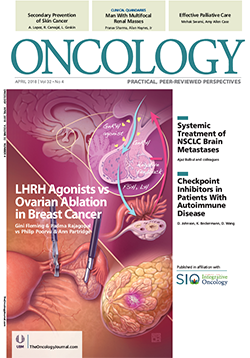COUNTERPOINT: LHRH Agonists vs Ovarian Ablation for Suppression of Ovarian Function in Premenopausal Breast Cancer Patients
Though LHRH agonists may be the preferred method of ovarian function suppression, ovarian ablation is a viable option for select premenopausal breast cancer patients.
Oncology (Williston Park). 32(4):168, 171, 179.

Philip D. Poorvu, MD

Ann H. Partridge, MD, MPH

Ovarian Ablation Is a Viable Option for Select Patients
Ovarian function suppression (OFS) has been recognized for more than a century as an active treatment for premenopausal women with breast cancer.[1] Ovarian ablation techniques, which include bilateral oophorectomy and bilateral ovarian irradiation, are associated with similar rates of response in hormone receptor–positive metastatic breast cancer and are considered permanent approaches to OFS.[2] Bilateral oophorectomy is used far more commonly than bilateral ovarian irradiation,[3] potentially due to concerns regarding unintended resumption of ovarian estrogen production following irradiation, as well as the additional benefit of ovarian cancer risk reduction with oophorectomy for women with BRCA1 and BRCA2 mutations.[4,5] Ovarian irradiation, delivered at a dose of 20 Gy in 10 fractions, appears to be safe, however, and represents an option when resource limitations or surgical contraindications, such as intra-abdominal adhesions, preclude oophorectomy.[5] While ovarian estrogen production is intended to cease irreversibly following oophorectomy or irradiation, OFS with luteinizing hormone-releasing hormone (LHRH) agonists reversibly suppresses ovarian function and is administered monthly or every 3 months for the desired duration of OFS. The ability to deliver reversible OFS is a major advantage; therefore, LHRH agonists represent the preferred approach for most premenopausal breast cancer patients. Yet, for a select group of these women, ovarian ablation with oophorectomy or irradiation remains an important treatment strategy.
Most premenopausal women with breast cancer are diagnosed at an early stage and are cured, while a smaller proportion develop metastatic breast cancer or present with de novo metastatic breast cancer. Response rates with OFS alone exceed 70% for premenopausal women with hormone receptor–positive metastatic breast cancer, similar to response rates with tamoxifen monotherapy[6,7]; the combination of OFS and tamoxifen is associated with improved overall survival compared with OFS or tamoxifen alone.[8] Therefore, OFS is now generally administered in conjunction with oral endocrine therapy and is a standard approach for premenopausal women with metastatic hormone receptor–positive breast cancer.[9] These patients generally receive indefinite OFS. In this situation, irreversible ovarian ablation may be preferred since it obviates the need for routine injections, potentially reducing the burden of treatment, which is frequently onerous for young women living with advanced breast cancer.
A higher number of breast cancer patients receive OFS in the adjuvant setting, in which it may be indicated for up to 5 years. Initial results from the Suppression of Ovarian Function Trial (SOFT) demonstrated that improvements in disease-free survival (DFS) with the addition of OFS to tamoxifen were limited to the subgroups who were very young (age < 35) or at high enough risk to receive chemotherapy.[10] After a median follow-up of 8 years, however, the DFS benefit was found to extend to the overall population (hazard ratio [HR], 0.76; absolute benefit, 4.2%), and a small, but statistically significant, overall survival advantage (HR, 0.67; absolute benefit, 1.9%) has been shown.[11] Combined analyses of SOFT and the Tamoxifen and Exemestane Trial (TEXT), in which patients were randomized to OFS with tamoxifen or OFS with the aromatase inhibitor exemestane, have demonstrated a 4% improvement in the DFS rate with the use of exemestane over tamoxifen.[12] While tamoxifen alone remains the appropriate approach to endocrine therapy for many premenopausal women at low risk of recurrence, the benefits of adding OFS to tamoxifen or combining OFS with exemestane will lead to even further use of OFS in breast oncology practice.
Patients and providers strongly value treatments that are less invasive; therefore, it is not surprising that 82% of women randomized to receive OFS in SOFT chose to receive an LHRH agonist as their sole form of OFS.[10] On the other hand, 18% of women chose to undergo an ovarian ablation procedure with bilateral oophorectomy or bilateral ovarian irradiation at some point in their adjuvant treatment, indicating that these methods are important options for a select population of young women with early-stage breast cancer.
Some women may undergo ovarian ablation to address suboptimal ovarian suppression, or “breakthrough” ovarian function, which may occur while on an LHRH agonist. Within the SOFT Estrogen Substudy (SOFT-EST), 34% of women who received triptorelin and exemestane had 1 or more estradiol levels above 2.72 pg/mL within the first year of treatment, which is the prespecified threshold for breakthrough, detectable only with a highly sensitive assay.[13] Even with a more liberal threshold of 10 pg/mL, the lower limit of detection on many assays, 18% of patients had 1 or more levels above the threshold in the first year of treatment. Aromatase inhibitors theoretically require the absence of ovarian estrogen production to be effective, whereas tamoxifen is active in the presence of circulating ovarian estrogen; therefore, breakthrough ovarian function may be more deleterious for women receiving aromatase inhibitors than for those receiving tamoxifen. Despite the occurrence of breakthrough in a minority of participants, women in the combined SOFT/TEXT analyses randomized to triptorelin and exemestane had improved DFS compared with those on triptorelin and tamoxifen. Other analyses have found no differences between OFS approaches, raising many questions about what breakthrough actually represents and how to use LHRH agonists[3,14]: Is breakthrough ovarian function associated with inferior outcomes? Should gonadotropin and estradiol levels be monitored routinely? How should OFS be managed in the setting of breakthrough? While oophorectomy and irradiation each represent viable options for patients experiencing breakthrough on reversible OFS, breakthrough can also potentially be managed by increasing the dose and/or frequency of LHRH agonist administration, with successful suppression of estradiol levels.
Despite being more invasive than reversible OFS, some women may choose ovarian ablation because of its convenience-oophorectomy is performed as a day surgery and radiation in a short course of treatment, after which there is no need for ongoing OFS treatments. Convenience may be particularly valuable to young breast cancer survivors, who often struggle to balance the requirements of their chronic treatment with the demands of young families, school, and employment.[15] While national consensus guidelines call specifically for monthly, rather than quarterly, LHRH agonist dosing, follicle-stimulating hormone and estradiol levels appear similar with the two dosing schedules, and it is not clear that disease outcomes are inferior with less frequent dosing.[9,16-18] Additionally, the financial toxicity of cancer care is increasingly recognized as an important issue,[19,20] and a 5-year course of monthly LHRH agonist injections may be associated with substantial out-of-pocket costs and may ultimately be more expensive to the patient than ovarian ablation.
Bilateral oophorectomy may also be a preferred approach for patients with inherited cancer predisposition syndromes. Women with germline BRCA1 and BRCA2 mutations have cumulative rates of ovarian cancer risk of 47% and 13%, respectively, by age 70.[21] Risk-reducing salpingo-oophorectomy substantially decreases the risk of breast cancer (HR, 0.49) and ovarian/fallopian tube cancer (HR, 0.21) for BRCA1/2 mutation carriers,[22] and reduces all-cause mortality (HR, 0.32), including in those with a personal history of breast cancer (HR, 0.29).[23] Many mutation carriers may prefer to undergo upfront bilateral salpingo-oophorectomy rather than receive an LHRH agonist first followed by oophorectomy in the future.
On the other hand, many young patients who plan to undergo oophorectomy in the future, including both mutation carriers and non-carriers, are interested in future fertility and may prefer to receive reversible OFS prior to undergoing oophorectomy after they have completed having biologic children.[24] For women who would otherwise regain ovarian function after the 5-year duration of reversible OFS, oophorectomy also exposes them to a greater duration of estrogen deprivation and greater long-term risks attributable to premature menopause[25-27]; therefore, many young women may prefer to regain menstrual function temporarily, with the goal of mitigating the long-term effects of premature menopause.
A small but significant proportion of women experience substantial symptomatology from OFS and opt to discontinue LHRH agonist therapy. While global measures of quality of life revealed similar outcomes among women receiving OFS compared with those receiving tamoxifen alone in SOFT, the addition of OFS to tamoxifen does result in clinically meaningful increases in hot flashes, vaginal dryness, and sexual dysfunction.[28] Rates of nonadherence to OFS among SOFT participants rose to 15% by the second year of treatment and to over 20% by the fourth year, which likely underestimates rates of nonadherence among non-trial populations receiving reversible OFS.[10] While poor tolerance of OFS should be addressed with supportive care measures as available, ovarian ablation is a reasonable strategy for the patient whose nonadherence to OFS stems from issues of cost or convenience. Regardless of the reasons why a woman may opt for ovarian ablation, we encourage such patients to consider 3 to 6 months of reversible OFS beforehand to ensure that the menopausal side effects are tolerable; if intolerable, tamoxifen remains a reasonable treatment option. For the select group of women who prefer to undergo ovarian ablation, these procedures address shortcomings of LHRH agonist therapy, add valuable cancer risk reduction, and remain important options for select premenopausal women.
Financial Disclosure:The authors have no significant financial interest in or other relationship with the manufacturer of any product or provider of any service mentioned in this article.
References:
1. Beatson GT. On the treatment of inoperable cases of carcinoma of the mamma: suggestions for a new method of treatment, with illustrative cases. Lancet. 1896;148:162-5.
2. Lees AW, Giuffre C, Burns PE, et al. Oophorectomy versus radiation ablation of ovarian function in patients with metastatic carcinoma of the breast. Surg Gynecol Obstet. 1980;151:721-4.
3. Tevaarwerk AJ, Wang M, Zhao F, et al. Phase III comparison of tamoxifen versus tamoxifen plus ovarian function suppression in premenopausal women with node-negative, hormone receptor-positive breast cancer (E-3193, INT-0142): a trial of the Eastern Cooperative Oncology Group. J Clin Oncol. 2014;32:3948-58.
4. Leung SF, Tsao SY, Teo PM, et al. Ovarian ablation failures by radiation: a comparison of two dose schedules. Br J Radiol. 1991;64:537-8.
5. Hughes LL, Gray RJ, Solin LJ, et al. Efficacy of radiotherapy for ovarian ablation: results of a breast intergroup study. Cancer. 2004;101:969-72.
6. Conte CC, Nemoto T, Rosner D, Dao TL. Therapeutic oophorectomy in metastatic breast cancer. Cancer. 1989;64:150-3.
7. Ingle JN, Krook JE, Green SJ, et al. Randomized trial of bilateral oophorectomy versus tamoxifen in premenopausal women with metastatic breast cancer. J Clin Oncol. 1986;4:178-85.
8. Klijn JG, Beex LV, Mauriac L, et al. Combined treatment with buserelin and tamoxifen in premenopausal metastatic breast cancer: a randomized study. J Natl Cancer Inst. 2000;92:903-11.
9. National Comprehensive Cancer Network. Breast Cancer. Version 4.2017. https://www.nccn.org/professionals/physician_gls/pdf/breast.pdf. Accessed March 6, 2018.
10. Francis PA, Regan MM, Fleming GF, et al. Adjuvant ovarian suppression in premenopausal breast cancer. N Engl J Med. 2015;372:436-46.
11. Fleming G, Francis PA, Láng I, et al. Randomized comparison of adjuvant tamoxifen (T) plus ovarian function suppression (OFS) versus tamoxifen in premenopausal women with hormone receptor-positive (HR+) early breast cancer (BC): update of the SOFT trial. Presented at the 2017 San Antonio Breast Cancer Symposium; December 5-9, 2017; San Antonio, Texas. Abstract GS4-03.
12. Pagani O, Regan MM, Walley B, et al. Randomized comparison of adjuvant aromatase inhibitor exemestane (E) plus ovarian function suppression (OFS) vs tamoxifen (T) plus OFS in premenopausal women with hormone receptor positive (HR+) early breast cancer (BC): joint analysis of IBCSG TEXT and SOFT trials. J Clin Oncol. 2014;32(suppl):abstr LBA1.
13. Bellet M, Gray KP, Francis PA, et al. Twelve-month estrogen levels in premenopausal women with hormone receptor-positive breast cancer receiving adjuvant triptorelin plus exemestane or tamoxifen in the Suppression of Ovarian Function Trial (SOFT): the SOFT-EST Substudy. J Clin Oncol. 2016;34:1584-93.
14. Pagani O, Regan MM, Walley BA, et al. Adjuvant exemestane with ovarian suppression in premenopausal breast cancer. N Engl J Med. 2014;371:107-18.
15. Jagsi R, Hawley ST, Abrahamse P, et al. Impact of adjuvant chemotherapy on long-term employment of survivors of early-stage breast cancer. Cancer. 2014;120:1854-62.
16. Masuda N, Iwata H, Rai Y, et al. Monthly versus 3-monthly goserelin acetate treatment in pre-menopausal patients with estrogen receptor-positive early breast cancer. Breast Cancer Res Treat. 2011;126:443-51.
17. Noguchi S, Kim HJ, Jesena A, et al. Phase 3, open-label, randomized study comparing 3-monthly with monthly goserelin in pre-menopausal women with estrogen receptor-positive advanced breast cancer. Breast Cancer. 2016;23:771-9.
18. Aydiner A, Kilic L, Yildiz I, et al. Two different formulations with equivalent effect? Comparison of serum estradiol suppression with monthly goserelin and trimonthly leuprolide in breast cancer patients. Med Oncol. 2013;30:354.
19. Davidoff AJ, Erten M, Shaffer T, et al. Out-of-pocket health care expenditure burden for Medicare beneficiaries with cancer. Cancer. 2013;119:1257-65.
20. Ramsey SD, Bansal A, Fedorenko CR, et al. Financial insolvency as a risk factor for early mortality among patients with cancer. J Clin Oncol. 2016;34:980-6.
21. Gabai-Kapara E, Lahad A, Kaufman B, et al. Population-based screening for breast and ovarian cancer risk due to BRCA1 and BRCA2. Proc Natl Acad Sci USA. 2014;111:14205-10.
22. Rebbeck TR, Kauff ND, Domchek SM. Meta-analysis of risk reduction estimates associated with risk-reducing salpingo-oophorectomy in BRCA1 or BRCA2 mutation carriers. J Natl Cancer Inst. 2009;101:80-7.
23. Marchetti C, De Felice F, Palaia I, et al. Risk-reducing salpingo-oophorectomy: a meta-analysis on impact of ovarian cancer risk and all cause mortality in BRCA 1 and BRCA 2 mutation carriers. BMC Womens Health. 2014;14:150.
24. Ruddy KJ, Gelber SI, Tamimi RM, et al. Prospective study of fertility concerns and preservation strategies in young women with breast cancer. J Clin Oncol. 2014;32:1151-6.
25. Rocca WA, Shuster LT, Grossardt BR, et al. Long-term effects of bilateral oophorectomy on brain aging: unanswered questions from the Mayo Clinic Cohort Study of Oophorectomy and Aging. Womens Health (Lond). 2009;5:39-48.
26. Colditz GA, Willett WC, Stampfer MJ, et al. Menopause and the risk of coronary artery disease in women. N Engl J Med. 1987;316:1105-10.
27. Davies MC, Hall ML, Jacobs HS. Bone mineral loss in young women with amenorrhea. BMJ. 1990;301:790-3.
28. Ribi K, Luo W, Bernhard J, et al. Adjuvant tamoxifen plus ovarian function suppression versus tamoxifen alone in premenopausal women with early breast cancer: patient-reported outcomes in the Suppression of Ovarian Function Trial. J Clin Oncol. 2016;34:1601-10.
